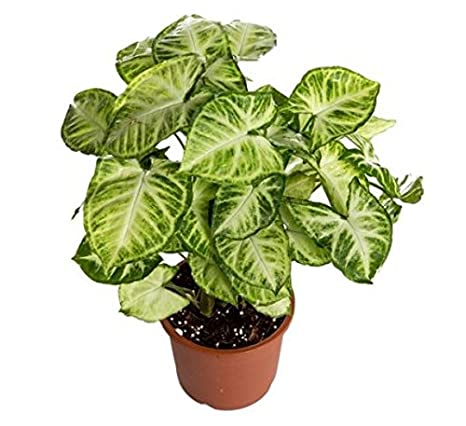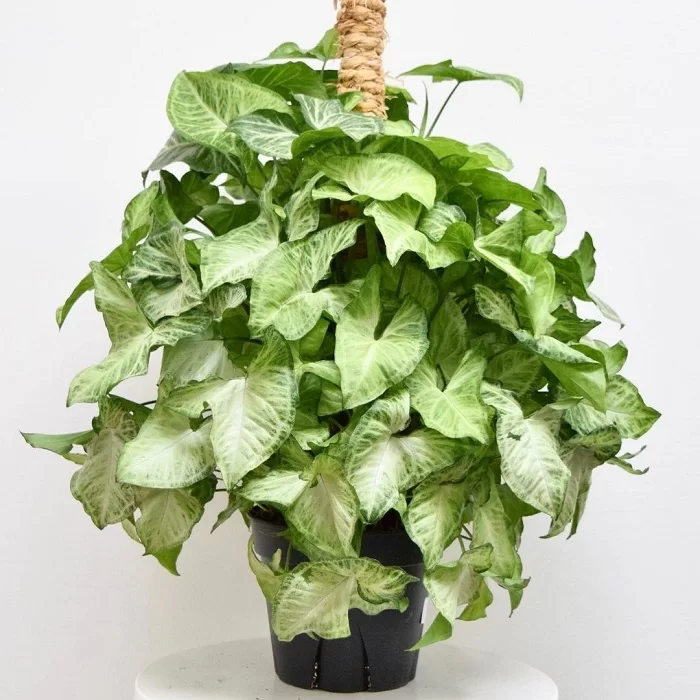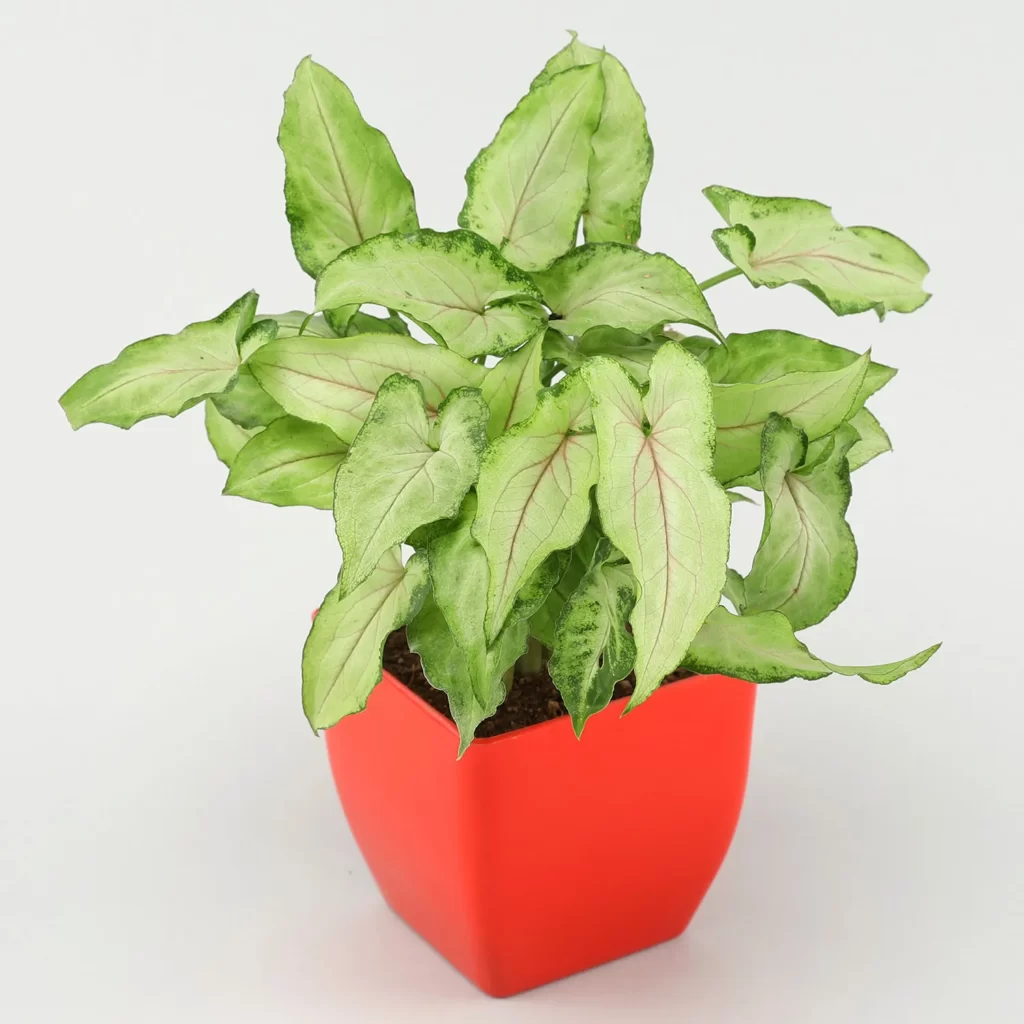
Introduction of Syngonium
Syngonium, also known as arrowhead, comes in numerous colors and variants; here, we’ll highlight the two most popular ones: pink and brown/bronze Syngonium.
Some species of the genus Syngonium, commonly known as American Evergreen and Arrow Head, are native to the tropical rain forests of southern Mexico, the West Indies, and Central and South America. The genus Syngonium contains a wide variety of vibrantly colored houseplants. Syngonium grows best at the low-light, human-comfortable temperatures found inside most homes in tropical regions. It needs less frequent fertilization and watering.
We have grown several types for over two years in a variety of indoor and outdoor settings (including living rooms, bedrooms, bathrooms, and heavy shades) in Delhi, and all of them have flourished despite the hot, dry climate. If kept inside, it will be perfectly content with a single monthly watering and a teaspoon of fertilizer each spring. This fast-growing plant can send out anywhere from one to three new shoots per year.
We give detailed instructions on lighting, fertilizing, and watering your plant once you purchase it. It’s convenient to have a natural air purifier plant that lasts a long time and works hard all day and night.
Plants can withstand being ignored in favor of bringing exotic beauty to interior design, improving air quality, aiding in the fight against sick building syndrome, and, last but not least, bringing good luck to the home or office.
Syngonium plants are mostly used for their aesthetic value, but they also serve as air purifiers and pollution barriers. Indoor air pollution, including harmful natural constituents like benzene, formaldehyde, toluene, and xylene, can be mitigated by using Syngonium. They increase humidity and cut down on bacteria in the air.
NASA and other agencies’ researchers have approved this plant for use as an air purifier, making it the best option. The leaves of a Syngonium plant can absorb pollutants, transport them to the root zone, and convert it into nutrients. Water vapors exhaled by houseplants help the plant draw dirty air down to its roots, where it can be transformed into plant food.
The value of having a pleasant place to live is universally recognized. From a Feng Shui perspective, your environment affects not just your material well-being, but also your physical and mental health, your relationships, and your professional and personal achievements in life. Feng Shui (pronounced “fung shway”) is an ancient Chinese practice that considers how the placement of furniture, plants, and other household items affects the flow of chi (pronounced “chi”) in your home. The quality of your life, both professionally and personally, is influenced by the way your energy flows. You are always influenced by Feng Shui, whether or not you are conscious of it
The meaning of the term Feng Shui
Composed of the Chinese characters for “wind” (Feng) and “water” (Shui), the name “Feng Shui” is often considered to be great (water). The only two natural components that move and circulate uniformly across the planet are wind and water. They’re essential for human survival, and they’re also the bare minimum. Without wind or air, we would perish in a matter of minutes. Additionally, water is the liquid of life; without it, human beings would perish in a matter of days. Climate is influenced by the interplay of wind and water, which in turn determines our access to food, which in turn impacts our way of life, health, energy, and disposition. These two ever-present constants have had a significant and ever-subtle impact on human beings and the societies in which they participate since the beginning of time.
Chi, often known as the life force, is the core of these vital substances. Since their essential nature is fluidity, wind and water are direct conduits of chi. These are the building blocks of every living thing on Earth. Therefore, Feng Shui is the practice of arranging physical spaces so that they promote a healthy flow of chi (or life force) for the people who live there.
Fengshui Yin and Yang Explained
When combined, Yin and Yang form a perfect whole. Yin and yang are the foundation of transformation. By definition, something that is whole cannot be broken or incomplete. Therefore, the yin and the yang, when separated, disrupt the harmony of the whole. The result is a mad dash for equilibrium as the two halves chase after one another. Yin is pronounced “shady side,” while Yang is “sunny side.” The Yin and Yang philosophy posits that opposites can coexist and even complement one another to create a harmonious whole. Everywhere we go, we see manifestations of Yin and Yang. Here are several pairs of Yin and Yang: night and day, female and male (Yang). Various Yin Yang categorizations have been used for thousands of years to classify and group a wide variety of topics. Plants are the embodiment of the wood element in Feng Shui (a life-giving element that oozes Yang energy). Therefore, you should strike a balance between Yang energy (represented by plants) and Yin components (such as shady locations that provide relief from the midday sun) to achieve optimal results. Some plants are naturally Yin and thrive in the shade, but in Feng Shui, most plants reflect Yang energy and require a significant amount of sunlight
Syngonium: A Perfect Feng Shui Plant

Syngonium podophyllum, most well known by its common names goosefoot and nephthytis, is regarded as a Feng Shui plant. The leaf of this plant is easily recognizable thanks to the gradual transformation from an arrow shape to a five-lobed form as the plant ages. As the fresh leaves are shiny and the older ones are matte, this Yin Yang balance is achieved by the five-lobed shapes, which represent the elements of water, fire, earth, wood, and metal.
Goosefoot (Syngonium podophyllum) leaves are symbolic of the five Feng Shui aspects because of their five lobes. That’s why it’s so effective in fostering good chi (or energy) and balancing out the negative Yin and Yang forces. Furthermore, it helps to purify the atmosphere. Syngonium podophyllum, more commonly known as goosefoot, embodies the uplifting, “upward” wood energy that is typically associated with the southeast or east. Set it up on your desk and let the spirit of spring, morning, youth, and new ideas help you become motivated.
If you have a Syngonium or goosefoot plant, you can place it indoors by positioning it in front of a sharp corner or angle that may be slicing the Chi. Conflict, worry, sleep problems, and anxiety will all diminish as a result. When chi travels along a smooth wall or surface, it becomes turbulent energy at the point where the wall or surface angles sharply. An angle can be mitigated by placing a Feng Shui plant in front of it.
This Syngonium Plant Helps Clean the Air
In addition to its aesthetic value, Syngonium plants also serve as air purifiers and pollution fighters. Plants like these can help clean the air inside your home by removing toxins including benzene, formaldehyde, toluene, and xylene. Along with increasing humidity, they kill off germs in the air.
This plant has been deemed the most effective air purifier by a team of researchers from NASA and other organizations. Pollutants are taken in through the leaves of Syngonium, then transported to the root zone where they are converted into nutrients. Water vapors released by houseplants attract pollutants in the air and carry them down to the plant’s roots, where they are transformed into nutrients.
Maintenance Tips for Syngonium
This species finds it quite easy to take care of others. No matter what you call it, Syngonium, Goosefoot plant, or Arrowhead Vine thrives in dim rooms. The arrowhead plant has been a favorite for over a century due to its longevity and low maintenance requirements. Because of its lush, bushy appearance even when young, arrowhead plants are popular options for decorating coffee tables, side tables, and other flat surfaces within the home.
Bright filtered light is ideal. As the leaves will quickly shrivel if exposed to direct sunlight, they should be kept out of the sun at all times. Turn the pot around if you see greater growth on one side; that side is probably getting more light (this will even grow out).
Don’t let the soil dry up while your plants are actively growing. In the winter, you should let the plant dry out a little bit between waterings.
Maintain the leaves dust-free by sweeping them off every other week. Misting the plant with water as often as possible would also be quite beneficial. If you prune your plant in the summer, it will produce new growth and look fuller
Read More: Give a gift of a plant in Bangalore
The Syngonium, a Phytophyte That's Nearly Impossible

The Syngonium podophyllum (Nephthytis or Arrowhead plant) is a resilient houseplant. This slow-growing tropical plant can be kept in a pot or hung upside down and does well with minimal attention. It’s an easy way to add color and texture to your space without a lot of work. It suffers occasional defeats, but it always manages to recover. Even though they look nearly dead, with some TLC (in the form of brighter lights and more water), they can be brought back to life and restored to their former glory. That’s why they’re suitable for people who aren’t very adept at taking care of plants: you won’t be able to kill them.
We use Pink Syngonium
The Pink Syngonium plant is a sight to behold, with its vivid hues and intricately patterned leaves. The plant prefers an indoor environment, where it may flourish and give visual appeal. Locations with lots of natural light, like your office or living area, would benefit greatly from this.
The dark brown or golden sporangium
Syngonium Brown does double duty by improving the aesthetics of your home while cleaning the air. The thick, hefty leaves make it a lovely ornamental choice. The oval leaves of this plant grow into a lobate form. This slow-growing tropical trailing plant can be grown in a container or hung from the ceiling. It’s up to you whether you put Syngonium Brwon in a window or outside.
